Introduction
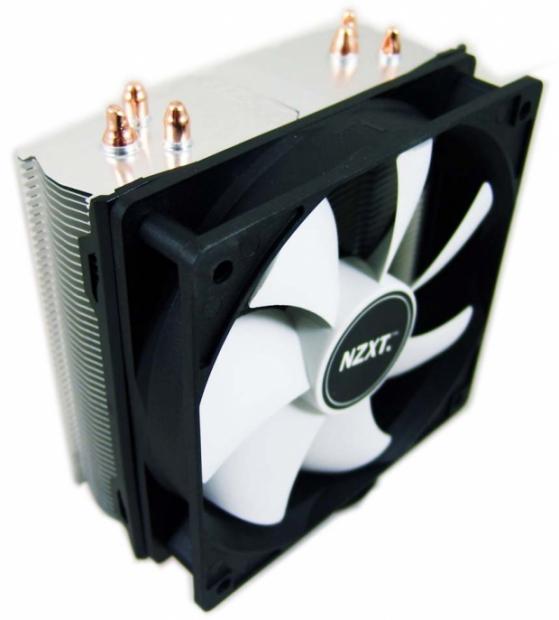
It has been quite a long time for me since I have mentioned air cooling and NZXT in the same sentence, but today that all changes. The last inception of an air cooler we had looked at from them was the HAVIK series of CPU coolers, and if memory serves me correctly, they were really good solutions for the time they were released. This time around with the new Respires Series of CPU coolers, the idea is to be compact using as many heat pipes as could be used in such tight confines to deliver , in their words, "ultra-high thermal transfer performance". While trying to stay within the tiny space allowed for tower coolers without cutting into other things like memory or hitting a GPU, this cooler should "vanquish heat without breaking the bank".
My first thought as I was reading the features page of the cooler was that "compact" doesn't mean it will perform poorly, just look at the Hyper 212 line. There are a lot of things that come into play, and as long as you get most of them right, you should be able to keep almost any processor in a reasonable temperature range. It isn't all about CFM these days, more coolers are relying on static pressure to rid new towers of the heat accumulated there, taking a page from the book of Noctua. Since I am already aware of the specifications, I can say the fan that comes along is capable in both CFM as well as static pressure, so it seems we should be good to go.
The new line of Respire Series coolers from NZXT comes with two offerings. First, and the one we will be looking at today, is a three pipe variant labeled the T20. There is also a slightly larger four pipe solution in the T40 that we will be looking at as well very soon.
As I said, these both were placed on the market to be affordable solutions with a bit of style, that should not just replace the ugly stock cooler, but as described, should allow a bit of headroom to overclock the CPU a bit. On that note, I say we look at the details, cruise through the images and get right down to what the Respire T20 is going to offer its users.
Specifications, Availability and Pricing

The Respire T20 from NZXT uses three pipes in its construction. The middle one is 8mm in diameter, while the two outer ones are 6mm in diameter to get as much heat pipe across the IHS as possible. To the top of these pipes there is an aluminum base that is used to accommodate the mounting hardware that uses epoxy to secure it to the pipes. The pipes then bend into a vertical alignment and have 48, 0.4mm thick, aluminum fins that are offset to angle slightly as the fan passes air through them. At the top, the half of a fin has the NZXT name on it and levels the top from the offset of the lower fins. Through the top come the three pipes on each side as the little bits of copper remnants are left exposed. Dimensionally the T20 stands 160mm tall, and is 124mm wide with the fan clips in use, and is only 65mm front to back including the 25mm of fan in play there.
To cool the stack of aluminum fins NZXT has employed the services of the DF1202512SELN 120mm fan. This fan is powered with a 3-pin fan connection and will run at full speed unless resisted with the included adapter. At full speed, this fan will spin near 1800 RPM while delivering 68.8 CFM and 2.26 mmH2O of static pressure and only with 34 dBA of noise. With the adapter in place, speed slows to 1300RPM with slightly less than 50CFM and only 26.5 dBA of noise. There is also the use of plastic fan clips that securely mount to this fan, and secure just as tight to the sides of the tower. Using rubber anti-vibration pads inside allows for less vibration from the fans into the body of the cooler to help keep annoying rattles and vibrations at bay.
Now I said right up front that the Respire Series of coolers are economically correct for these harsh times. Looking back at some of the news releases of the T20 we are about to see there was an MSRP set at $29.95 for the T20. Now I did struggle a bit, even to find an e-tailer that is showing current stock of the Respire T20, but I was able to find at least one at the moment, and likely there will be more by the time you read this. I located it at Amazon.com, and at a listing currently of $29.99 with free shipping. It doesn't look like there is any price gauging for the holiday season either.
At this price point the CM Hyper 212 Plus/Evo and the Xigmatek Gaia as other offerings in this range come to mind. So let's get to it and see what NZXT offers in this compact Respire T20 CPU cooler.
Packaging

The white box is very clean looking with just splashes of the light blue dashes in the back with the T20 standing large and in charge on the front panel. At the bottom next to the naming are icons denoting the ease of installation, the three pipes, the Seamless Direct Touch base, and the compact nature of the design.

On the right panel you start to look at the dimensional renderings, three in total, to give you an idea of the room it uses, or rather doesn't use. Then at the bottom half is where NZXT places the specifications chart that we just discussed on the last page.

On the back there is a head on look at the T20 stating they use a 120mm fan and show some of the specs, while on the other side of the cooler they discuss the heat pipes. The four images at the bottom show off the stack of fins and the angle used, the sturdy fan clips, the base, and the universal mounting hardware.

The last side of the packaging offers you a look at the side of the T20 followed by a description of the reasoning and ideas behind the Respire Series of CPU coolers. Finishing things off is a list of both Intel and AMD supported CPUs to place under this T20.

Inside of the box there is a thin plastic tray that supports the T20 in the center of the box. Near the base of the cooler, under the tray is where you will locate all of the included hardware, and the back plate is snapped into the tray under the cooler in its own little pocket.
NZXT Respire T20 CPU Cooler

Once out of the packaging you can see the 120mm fan chosen with the seven white blades and black frame covers more than the fins behind it. Just slightly missing the corners of the fin body, this fan should have no issues cooling these fins.

From the right side of the T20 you can see the fan is near as thick as the fins behind it. With the use of three pipes with the fatter one in the middle, it doesn't leave a lot of room for them to go through the aluminum fins.

From the back you can now see the angle of the 48 fins, and you can also see the half of a fin on the right side at the top. You can also see that due to the thin depth of the cooler, the 8mm pipe has to be offset from the 6mm ones to allow them all to fit.
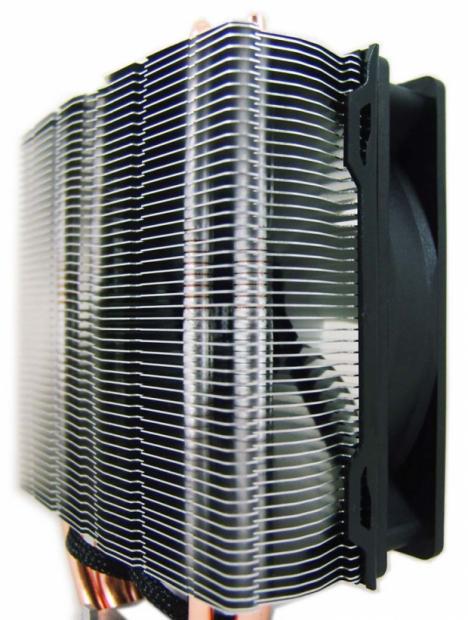
The fan clips use these two tabs on each side of the cooler to lock the fan onto the fins. You can see the design would allow for a second fan, but no extra clips are included.

To hold the new hardware in place, NZXT uses this rough cut aluminum block to space the hardware properly and to give it something to buffer the pipes from damage. Since this cooler uses direct contact of the pipes to the IHS, NZXT decides to use some sort of epoxy to mount the aluminium to the pipes. It must be affordable, because they use a lot of it.

To keep the milled surface protected and to help prevent oxidation of the surfaces there is this clear sticker used that must be removed prior to installation.

As far as a direct contact cooler goes, I have seen better. While the copper and aluminium is milled flat across all of their surfaces, there are sizable gaps between the pipes and between them and the base. I would apply TIM just down the pipes to install this cooler.

Removing the fan from the cooler I flipped it around so we could see the DF1202512SELN fan chosen to cool the T20. You can also see you do get a black braided covering to the three pin wire.

The fan clips used here get screwed directly to the fan at the top and bottom of either side. Once they are screwed on, NZXT places a bit if rubber padding over the screw to isolate the fan from the cooler making the clips crab the cooler a little tighter.
Accessories and Documentation

Breaking the hardware up a bit to make it easier to cover, here we have all of the structural components. On the left are the Intel top brackets, in the middle are the top cross bar and the back plate, and this leaves the AMD top brackets on the right.

This is the rest of the kit. On the left are the threaded screws for LGA2011 only, in the middle there is the 7.5V fan power resistor, an envelope of TIM, four plastic risers and four thumbscrews. On the right side there are the threaded legs for all other sockets and the two nuts to mount the cross bar to the rest of the socket hardware.

The paperwork that comes along with the Respire T20 is multi-lingual throughout each step of the installation. Not only do you get the parts all shown with a description next to them, but there are larger illustrations for the step by step instructions that just with images alone can guide you through the installation process. This is a good thing to, because each step has eight translations of the text, they are limited in space to what can be said.
Installation and Finished Product

I installed the back plate with the Intel tabs on the board for this Z68 motherboard, and the holes in the plate allow this to go on both ways with holes for the screws at both ends. Something to help you set the screws in the plate is the line across the head denoting the flat side of the screw to line up correctly in the back plate.
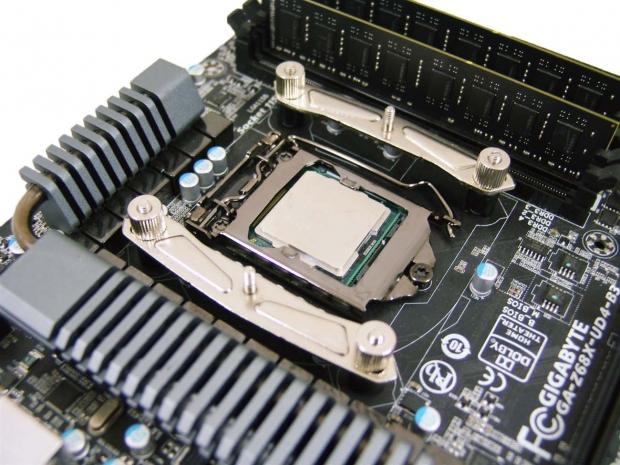
Once the back plate is in place and the screws are in the board, you simply press on the black plastic risers and then set on the top plates. Arrows pointing in, I attached the top plates with the set of four thumbscrews until they stopped turning.
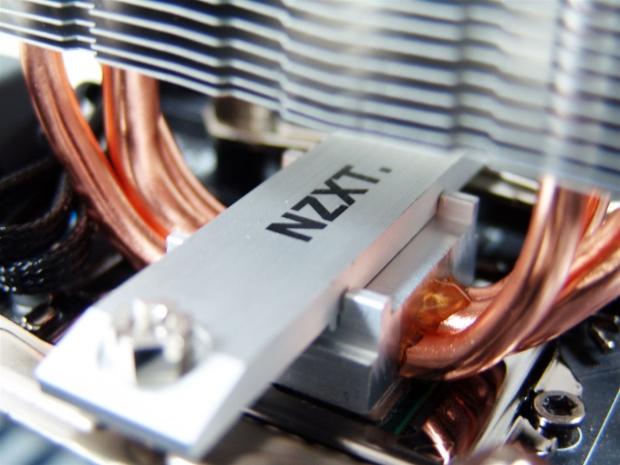
After applying TIM to each of the heat pipes and setting the cooler on the CPU, I then slid over the top bar that applies pressure to the cooler. Each end has a hole that lines up with the studs in the top plates and will allow you to screw the nuts down, again until they stop spinning.

Looking down onto the Respire T20, you can really get a sense of just how thin this cooler really is. While the fan on the front does cover the hardware and needs to be off to install the cooler, the back side of the cooler leaves plenty of room to attach the 8-pin EPS cable.

From this angle you can see that the Respire T20 and the fan on the front sit much higher than my bare memory that I use. Not that this is an issue anyways, but you can easily use much taller memory with this cooler.

Here is why. Even if the fan were to sit lower, it is completely clear of all four of my DIMM slots and will absolutely allow for any size of heat sinks on the memory.

This last image is just the last in a series, the glamour shot if you will, before we release the hounds and push this cooler with everything we got.
The Test System and Thermal Results

I would first like to thank HIS, GIGABYTE , InWin and AVADirect for supplying products for me to test with.
Testing for the CPU coolers is done with the use of RealTemp to ascertain temperatures, Intel Burn Test to deliver the load to the CPU and CPU-Z to verify the CPU speed and the voltage being used in Windows. All of the testing is done with an ambient temperature of 24.5-25°C and humidity is maintained to 35% sometimes less.
For the "stock" runs, it's more of a plug and play setup where the PWM of the motherboard is in control of the fans speeds for both the idle and load results. Speed Step is active and the processor idles at 1600 MHz and loads at 3500 MHz for the stock settings. I also set the memory to run at 1600 MHz for stock. As for the overclocked runs, I load the CPU at 4.5 GHz and idle results are obtained with 7.5V to the fans while the load run is set to deliver 12V to the fans. This allows me to gauge the lowest and highest fan ratings for my charts.

At idle the Respire T20 starts out really well. With the fan spinning at 1300 RPM the temperature rested at 26 degrees, and with slightly more voltages for the overclock, and the fans now going at 1800RPM the T20 holds on strong and only raised a degree with the extra voltage.

Once the testing was applied to the CPU, and in turn the respire T20, the results are less than expected. At stock levels we hit 57 degrees and only besting three other coolers at this level of heat production.
Once I applied the overclock things get really dicey. I sat and watched in astonishment as the CPU was allowed to get to 92 degrees before things leveled off. The Respire T20 is a good stock replacement, but I think a low TDP rating should be applied as not to lull customers into thinking this is the replacement for all the coolers that came before it in this price range. To me this just isn't a choice for overclockers.
Noise Level Results

Since PWM does not work with these fans, in order to lower the speed and noise levels, you have to install the resisted adapter that NZXT supplied to run the fans around 1300RPM. At a speed of 1375RPM with the resistor in place, the fan registered at 35 dB which is really good for users looking for a silent solution.

Staying at the top of the chart even at full speed, the T20 comes in with a 45 dB reading with the fans spinning at 1875RPM, verified in BIOS and with AIDA64. To be honest, I truly think customers would have welcomed noise into the high 50's in gaming situations if the performance was much better than what we just saw here.
Final Thoughts
At first I really had high hopes for this cooler, but unless you keep your processor near idle all the time, I don't see a real need to make the jump from a stock cooling solution to the Respire T20. Before I get too deep into that, let's discuss the plus side of things. The cooler is compact and stays inside of the limited CPU area. It does allow room over all of the memory slots and won't cause issues even if the sport the tallest heat spreaders on the market. The T20 is relatively light, its rattle free, and is much quieter than a stock cooling solution. Outside of aesthetic appeal, and some noise reduction, the Respire T20 now runs out of tricks.
Performing at the bottom of the charts with the 2600K at stock clocks isn't all bad - I mean, I was able to keep my CPU under 60 degrees when it was loaded. When the OC was applied, the cooler had to show its hand as the CPU calls its bluff. There is a bright side to this as well though, at least it didn't allow the CPU to throttle and did allow me to complete the 50 passes of the testing. It is a real shame that they don't include an extra set of fan clips, at least then customers would have a slight chance to stay in the 80's with a mild OC such as the one I use for testing. On the flip side of the cooler, I didn't like the look of all the epoxy oozing out of the base, and the top piece looked like something someone cut out in high school shop class, but the hardware was simple to use and install. It also supplied ample pressure when mounting the cross bar that I am sure it was a saturation issue in the fins and not a contact issue that drove the temperatures so high. This is also why I would add some sort of TDP rating to this cooler to let buyers know that this isn't intended to overclock with.
The one good thing about the T20 that may make most of you take my previous words with a grain of salt and buy one of your own anyways; it's the price. At $29.99 you are very limited to any sort of selections that don't look like an HP OEM cooler or something from 1995. I also know most of you have much better fans on hand and may want to try your hands at a dual fan arrangement, and at this price, I say go for it. While it may not be the best cooler out of the box, throw in some ear plugs and grab a pair of Delta fans off the shelf and get that leaf blower doing its thing.
As far as the Respire T20 is concerned, out of the box, I would pass, and hopefully its large brother we will be testing soon, the T40 can do something to save the Respire name, because as of this moment, the Respire Series is breathing with ventilator assistance, this cooler just can't do it anymore on its own.


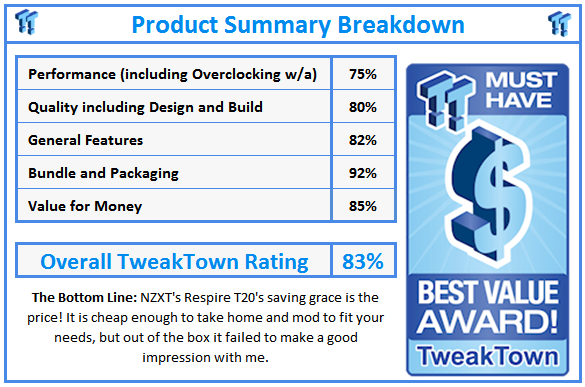
 United
States: Find other tech and computer products like this
over at
United
States: Find other tech and computer products like this
over at  United
Kingdom: Find other tech and computer products like this
over at
United
Kingdom: Find other tech and computer products like this
over at  Australia:
Find other tech and computer products like this over at
Australia:
Find other tech and computer products like this over at  Canada:
Find other tech and computer products like this over at
Canada:
Find other tech and computer products like this over at  Deutschland:
Finde andere Technik- und Computerprodukte wie dieses auf
Deutschland:
Finde andere Technik- und Computerprodukte wie dieses auf